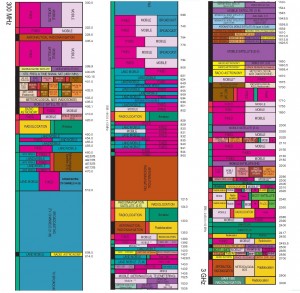The Spectrum Challenge
Imagine you’re a regulator and your job is to find some space in the spectrum map to meet the demand for mobile broadband. Here’s a close approximation of the existing allocation map for the sweet spot between 300 MHz and 3 GHz (click for larger image:)
Here’s a more detailed breakout. The US is in international region 2.
What do you move, where do you move it, and how do you justify your choices?
It seems to me that the hardest question is how we justify the re-arrangement of the map, and to do that we need to establish some basic criteria. One thing that really jumps out at me is the large number of special-purpose allocations that have been made for on an application-by-application basis.
There are a large number of allocations for very narrowly-defined services, such as time signals, meterological aids, aeronautical mobile communication, aeronautical radio navigation, radio navigation satellites, aeronautical telemetering, and a number of satellite services. Do all of these things need to be supported as custom applications, or can a more general-purpose system take their place more efficiently?
The allocation seems to have been made for a two-dimensional world, in that they ignore the fact that some services, say airplanes communicating with satellites while in the air, take place well above the realm of terrestrial radio communications from a radio tower down to the ground. Isn’t it possible to aim radio beams such that planes use the space above 10,000 feet and smartphones use the space below 300 feet? It seems plausible to me.
And what happens when we consider the fact that multiple digital services can use the same frequencies without interfering with each other as long as their encodings don’t collide, the CDMA principle? And can’t we use Spatial Division Multiple Access (SDMA) to create directional tunnels that don’t interfere with each other? Seems to me that we can.
So let’s pretend that the map represents a set of services rather than a specific allocation and devise a scheme for re-packing the services more efficiently in the 300M – 3G spectrum. It should be a fun exercise, and I’m going to ask some spectrum experts to weigh in with their recommendations.
Spread the word and comment. The best suggestions will be recorded in future posts here.





[…] do you move it, and how do you justify your choices? Richard Bennett has an interesting post on Hightech Forum. […]
Nothing obvious to me. I’ll ask that this question be reposted after the publishing of a spectrum inventory based in part on real-world spectrum occupancy.
The state of the art of dynamic spectrum access systems, including cognitive radios, is proceeding well as can been seen from some of the comments in the FCC’s Notice of Inquiry on dynamic spectrum access. I think the spectrum inventory will show opportunities to use these systems on a secondary basis with current primary users in some of these bands. For example, I think we’ll see that the 1435-1525 flight test telemetry band is relatively lightly used, as anecdotal evidence suggests. The 960-1215 aeronautical radionavigation band is one to look at as well, for such secondary use purposes, at least. There are plans to evolve aircraft navigation to GPS and other systems; maybe some of that band opens up as a result.
Some of these bands are reserved on a worldwide basis, such as that aeronautical band, and don’t lend themselves to repacking as easily as others. Also, most anything we do with spectrum in the US has to be coordinated with Canada and Mexico (border issues); that’s non-trivial.
Though repacking of allocations is hard now, repacking within allocations of existing users may facilitate the deployment of dynamic spectrum access systems through the creation of larger blocks of vacant spectrum. It will be easier for these systems to string together fewer and larger blocks of spectrum than more, smaller blocks.